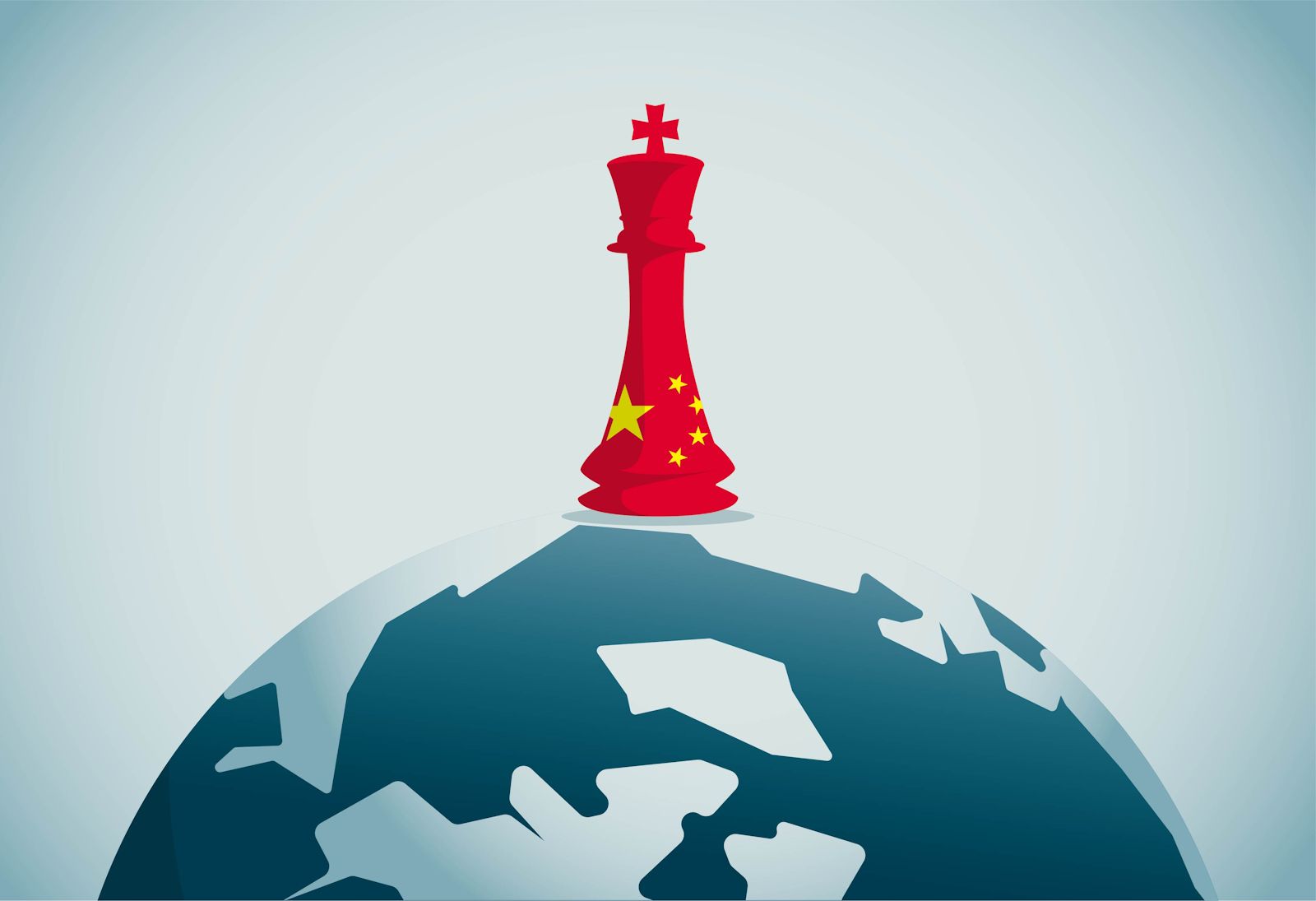“The Rise of AI Giants: China’s Technology Sector Sets the Pace for Global Innovation”
In a world where technological advancements are rapidly transforming industries and economies, one sector stands out for its unparalleled pace of innovation and market dominance: the Chinese technology sector. For decades, China has been the birthplace of some of the world’s most influential technology innovations, from the smartphone to the cloud. As the country continues to evolve and expand its global influence, the technology landscape is undergoing a profound transformation. In the midst of this revolution, the city of Shenzhen, home to many of China’s largest tech companies, has emerged as a hub of AI innovation, driving technological advancements that are redefining the global market. But what is behind this remarkable rise to prominence, and how are China’s domestic powerhouses adapting to the changing landscape?

Debunking the Myth of China’s Limited Innovation Capacity

Unionjournalism explores the evolving narrative around China’s technological innovation. For years, the perception has been that China’s capacity for technological innovation was limited, with the country often characterized as a hub for imitation rather than innovation. However, this view is increasingly being challenged by evidence of significant advancements and a growing ecosystem that supports innovation. Despite initial skepticism, China’s progress under the MIC2025 initiative has been substantial, with achievements that have outpaced many expectations.
According to the South China Morning Post, China has met or exceeded over 86% of the objectives outlined in the MIC2025 initiative. This includes significant advancements in sectors such as robotics, aerospace, and biopharmaceuticals, where China aimed to achieve 70% domestic production of core components by 2025. The initiative’s success is a testament to China’s commitment to transforming its manufacturing sector into a hub of innovation and technological leadership, which has not only led to increased domestic production but also has significantly reduced its reliance on foreign technology.
China’s rapid advancements are not just a matter of domestic policy success; they reflect broader changes in the country’s economic and technological landscape. The nation’s push towards innovation is supported by a robust ecosystem of research, development, and investment. The Information Technology and Innovation Foundation (ITIF) has noted that Chinese firms are catching up rapidly across various sectors, driven by a combination of state support and market-driven incentives. This combination has fostered a culture of innovation that is challenging the traditional perception of China as a mere producer of low-cost goods and services.

China’s Innovation Advantages and Challenges
Key Advantages
- Government Support and Funding: The Chinese government has invested heavily in research and development (R&D), with a particular focus on advanced technologies such as artificial intelligence (AI), quantum computing, and biotechnology. This support has led to the establishment of numerous innovation hubs across the country, facilitating collaboration and knowledge sharing.
- Large Domestic Market: China’s vast market provides a substantial testing ground for new technologies, enabling companies to scale rapidly. This large customer base allows for the rapid iteration and refinement of products and services, which can then be exported globally.
- Strong Technological Infrastructure: The country has invested significantly in infrastructure, including high-speed internet and digital connectivity, which supports the development and deployment of new technologies.
- Intellectual Property (IP) Issues: Despite advancements, China still faces challenges related to intellectual property rights (IPR). The protection of IPR remains a contentious issue, affecting both domestic and foreign companies operating in the country.
- Short-term vs. Long-term Thinking: While there is strong government support for innovation, there can be a tendency towards short-term gains that may undermine long-term technological development.
- Global Competition and Sanctions: China faces increasing competition and regulatory scrutiny from other countries, particularly the United States, which has imposed sanctions and restrictions on technology transfers and R&D collaborations.
Challenges

Analysis of China’s Innovation Ecosystem and Future Prospects
Understanding China’s innovation ecosystem is crucial for gauging its future prospects. China’s innovation ecosystem is characterized by a blend of government-led initiatives, private sector investments, and a rapidly expanding base of skilled labor. The MIC2025 initiative has been pivotal in fostering this ecosystem, focusing on enhancing core competencies in high-tech areas and promoting innovation-driven growth. The ecosystem has evolved to encompass a diverse array of stakeholders, including universities, research institutions, and private companies, all working in concert to drive innovation.
The role of state investment cannot be overstated in this ecosystem. China’s state-backed R&D spending has directly contributed to the development of numerous innovative technologies and products. According to the ITIF, China’s R&D investment has surged, with a particular focus on emerging technologies. For example, in AI, China has been a leader in patent applications, with a growing number of patents being filed in areas like machine learning, natural language processing, and computer vision.
However, the future of China’s innovation ecosystem will hinge on overcoming certain challenges. Intellectual property protection remains a critical issue that could hinder long-term innovation. The ITIF’s findings indicate that while China has made strides in IPR, there is still a need for continued reform and vigilance to ensure that the ecosystem remains conducive to innovation. Additionally, balancing short-term economic goals with long-term technological development will be crucial for sustained innovation and global competitiveness.
Given the current trajectory, the future prospects for China’s innovation ecosystem look promising. The government’s commitment to fostering innovation, alongside the growing capabilities of domestic enterprises, suggests that China is well-positioned to maintain and expand its global technology leadership. As China continues to refine its ecosystem, it is likely to see further advancements in technology sectors, potentially leading to a more balanced and sustainable approach to innovation and economic growth.
Strategic Foresight and Tactical Adaptability
The Importance of Future Readiness in a Dynamic Business Environment
Future readiness is a critical trait for companies seeking to thrive in today’s rapidly evolving technological landscape. It involves the ability to anticipate and adapt to external changes, a capability that is increasingly essential for long-term success. In a world where technological advancements and market trends are shifting at unprecedented speeds, companies that lack future readiness risk being left behind. Strategic foresight and tactical adaptability can make the difference between a company that merely survives and one that thrives in the global marketplace.
Measuring Future Readiness: The Future Readiness Indicator
The Future Readiness Indicator (FRI) is a tool designed to assess a company’s readiness to navigate future technological and market trends. The FRI employs a rule-based methodology to generate a composite score that reflects a company’s preparedness. Key factors evaluated include:
- Financial Fundamentals: The financial health of a company, including financial stability and growth potential.
- Investor Expectations: The market’s expectations regarding future growth and innovation.
- Business and Employee Diversity: The diversity of skills, perspectives, and backgrounds within a company, which can drive innovation and adaptability.
- Innovation: The company’s efforts in R&D, new product development, and technological advancements.
- Cash and Debt Management: The company’s financial management practices, including the management of cash reserves and debt.
The FRI is based on publicly available data, incorporating information from company websites, annual reports, business models, press releases, and third-party sources such as CrunchBase, Espacenet, Sustainalytics, and Google Trends. This multi-faceted approach provides a comprehensive assessment of a company’s future readiness, helping stakeholders understand not only current strengths but also potential areas for improvement.
Practical Applications of Future Readiness in Business and Industry
For businesses and industries, the practical application of future readiness involves a proactive approach to adapting to technological and market changes. Companies must adopt a long-term strategic vision while maintaining the flexibility to respond tactically to immediate challenges. This dual approach allows companies to anticipate and prepare for future technological trends, such as the rise of AI, the Internet of Things (IoT), and sustainable technologies.
One practical example is the Chinese company Huawei, which has consistently invested in R&D and innovation, leading to groundbreaking advancements in areas like 5G technology. Huawei’s foresight in investing in 5G infrastructure and related technologies has positioned it as a global leader in telecommunications, demonstrating the potential of strategic foresight and adaptability. Another example is DJI, a leading drone manufacturer that has continually adapted its technology and business models to stay ahead of competitors and meet evolving market demands.
Adapting to Change and Emerging Trends
Anticipating and Responding to External Changes
Adaptability is a critical component of business resilience in a rapidly changing global market. Companies must be able to anticipate changes and adapt their strategies and operations accordingly. Anticipating changes involves analyzing market trends, technological advancements, and regulatory shifts to understand potential future scenarios. Responding to these changes requires a mix of strategic foresight and tactical adaptability, allowing companies to not only survive but also thrive amidst uncertainty.
The Role of Innovation and Adaptability in Sustained Profitability
Innovation and adaptability play a pivotal role in ensuring sustained profitability in a competitive global market. Companies that can innovate effectively are better positioned to create unique products and services that meet evolving customer needs and preferences. Adaptability, on the other hand, ensures that companies can navigate market disruptions and shifts effectively, maintaining their competitive edge. A balance between innovation and adaptability is key to long-term success, as it allows companies to continuously evolve and improve their offerings in response to market dynamics.
Examples of Companies That Have Successfully Adapted to Change
- Alibaba: As a leading e-commerce and technology company, Alibaba has demonstrated a remarkable ability to adapt and innovate. From its early days as an online marketplace, Alibaba has diversified into cloud computing, AI, and financial services. This diversification and continuous adaptation have helped Alibaba maintain its competitive edge and profitability.
- BYD: BYD, a major player in the automotive and battery industry, has successfully transitioned from a battery manufacturer to a leading electric vehicle (EV) producer. BYD’s strategic foresight in investing in EV technology and its adaptability in scaling up production to meet growing global demand have positioned it as a global leader in the EV market.
Conclusion
Here is a comprehensive conclusion for the article:
In conclusion, China’s technology sector has emerged as a global leader in AI innovation, driven by the diversification of domestic powerhouses such as Alibaba, Tencent, and Baidu. As discussed in this article, these companies have not only expanded their presence in the domestic market but have also ventured into new areas such as artificial intelligence, cloud computing, and fintech. The Chinese government’s supportive policies, massive investments in research and development, and the availability of a vast talent pool have created a conducive environment for AI innovation to flourish.
The significance of China’s AI-driven technology sector cannot be overstated. Its implications extend beyond the realm of technology to impact the global economy, trade, and geopolitics. As China continues to drive AI innovation, it is likely to reshape the global technology landscape, posing challenges as well as opportunities for businesses and governments around the world. Moreover, the rise of China’s tech giants has far-reaching implications for data privacy, cybersecurity, and the future of work, making it essential for stakeholders to engage in a nuanced and informed discussion about the benefits and risks associated with AI.
As we look to the future, it is clear that China’s technology sector will continue to play a pivotal role in shaping the global AI landscape. The question is, what does this mean for the rest of the world? Will other nations be able to keep pace with China’s AI innovation, or will they be left behind? As the world grapples with the implications of AI, one thing is certain – China’s technology sector will be at the forefront of this revolution, driving innovation, growth, and transformation. As the ancient Chinese proverb goes, “When it is obvious that the goals cannot be reached, don’t adjust the goals, adjust the action steps.” The world would do well to heed this advice as it navigates the uncharted territory of AI innovation, led by China’s trailblazing technology sector.
